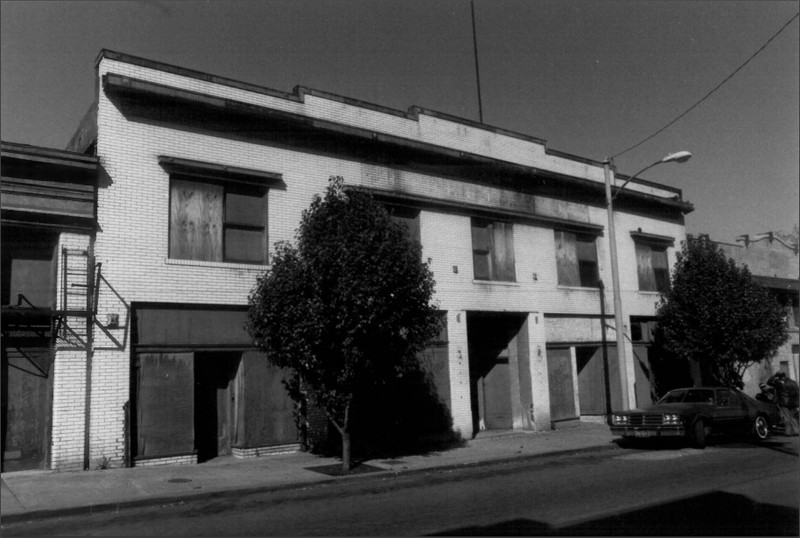The Roberts Building
Introduction
Author-Uploaded Audio
Introduction to the building by Michael Patton; recording created by Black Archives of Mid-America
Text-to-speech Audio
Though it currently sits empty, the building on the northwest corner of 19th and Vine has a long history as an economic staple of the 18th and Vine area. Constructed in 1923, the building was initially owned by a realtor named John T. Sears. Soon after construction was complete, entrepreneur Homer B. Roberts purchased the building from Sears for around $70,000. In the building, Roberts established a highly successful car dealership, as well as housing several other Black-owned businesses and providing jobs to African-American people in the area. Beyond the car dealership, Homer Roberts was a major community figure throughout much of his life, starting multiple businesses and serving in the Army during both World Wars. According to an article in the Kansas City Call, Roberts later worked for the Pentagon, facilitating public relations between Black publications and the military.
Images
A picture of the Roberts Building, photographer unknown. Taken by Thomason and Associates, Dated September 1989

Backstory and Context
Text-to-speech Audio
Homer B. Roberts was born in Ash Grove, MO in 1888. According to a biography of him published by Kansas City Black History, Roberts grew up in Wellington, KS before attending the Tuskegee Institute and pursuing a degree in electrical engineering at Kansas State Agricultural College (Now Kansas State University) in Manhattan, KS. During the First World War, Roberts enlisted in the Army Signal Corps, becoming the first African-American lieutenant in that unit, and served on the Western Front. When the war ended, Roberts became aware of a growing market for automobiles among African-American consumers, a majority of whom were priced out or otherwise excluded by white-owned dealerships. Initially, Roberts served as a broker between white-owned dealerships and Black customers, as the dealerships believed "Blacks could sell best to Blacks". (Gould) In 1923, Roberts expanded his business when he purchased what would become the Roberts Building on Vine Street, opening the Roberts Motor Mart. The building also housed restaurants and medical offices.
According to a 2016 blog post by CollisionWorks, Roberts sold cars produced by Hupmobile, Rickenbacker, Whippet, Marmon, and Oldsmobile, making use of advertisements in the Kansas City Sun and Kansas City Call. Roberts did brisk business out of this location for several years, before moving to Chicago with business partner Kenneth Campbell to form the Roberts-Campbell Automobile Agency, which continued to sell cars to Black consumers. Unfortunately, both the Vine Street location and the Agency at large did not last very long after this move, closing sometime in the 1930s. A website on the history of African-American car dealers cites growing interest from white-owned dealerships as a factor of this closure. In 1941, Roberts returned to the Army at the onset of World War Two, eventually attaining the rank of Major. According to an article from the Kansas City Call, he was appointed the provost marshal of Fort Huachuca in Arizona. Kansas City Black History states that Roberts also worked for the Pentagon in a public relations capacity, by "traveling to Europe, Africa, and extensively across the U.S., he promoted the contributions of Black soldiers and communities to the war effort." The article also mentions that Roberts was awarded the Legion of Merit. After the war, Roberts worked for a publishing company founded by Carter G. Woodson. Roberts died of a heart attack at his home in Chicago on July 23, 1952.
Sources
“Black History Month: Pioneering African American in the Automotive Industry – Homer B. Roberts.” CollisionWorks Collision Repair Centers. Retrieved by WayBack Machine, February 23, 2016. https://web.archive.org/web/20160223204510/http://www.collisionworksokc.com/2016/01/02/Black-history-month-pioneering-african-american-in-the-automotive-industry-homer-b-roberts/.
Gould, Mike. “The Pioneers.” African-American Automobile New Car Dealers - The Men. Retrieved from WayBack Machine, March 5, 2016. https://web.archive.org/web/20160305070107/http://www.aacardealers.com/men.html#roberts.
“Homer B. Roberts: Kansas City Black History.” KC Black History. Accessed November 29, 2022. https://kcBlackhistory.org/articles/homer-b-roberts.
National Register of Historic Places, 18th and Vine Historic District, Kansas City, Jackson County, MO, National Register #84004142
“Roberts Building.” African American Heritage Trail of Kansas City. Accessed November 28, 2022. https://aahtkc.org/roberts-building.
Unknown. “Death To Homer B. Roberts - Former Kansas Citian Dies of Heart Attack.” Kansas City Call, July 25, 1952.
National Register of Historic Places Registration Form, 18th and Vine Historic District, Kansas City, Jackson County, MO, National Register #84004142
